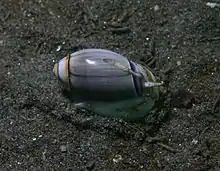Olivellinae
Olivellinae, common name the "dwarf olives", are a subfamily of small predatory sea snails with smooth, shiny, elongated oval-shaped shells. The shells sometimes show muted but attractive colors, and may have some patterning. [1]
| Olivellinae | |
|---|---|
 | |
| Olivella biplicata | |
| Scientific classification | |
| Kingdom: | |
| Phylum: | |
| Class: | |
| (unranked): | |
| Superfamily: | |
| Family: | |
| Subfamily: | Olivellinae Troschel, 1869 |
| Genera | |
|
See text. | |
These animals are marine gastropod molluscs in the superfamily Olivoidea, within the clade Neogastropoda according to the taxonomy of Bouchet and Rocroi.
Distribution
Olivella snails are found worldwide, in subtropical and tropical seas and oceans.
Habitat and habit
These snails are found on sandy substrates intertidally and subtidally. These snails are all carnivorous sand-burrowers.
Shell description
The shells are basically oval and cylindrical in shape. They have a well-developed stepped spire. Olivella shells have a siphonal notch at the posterior end of the long narrow aperture. The siphon of the living animal protrudes from the siphon notch.
The shell surface is extremely glossy because in life the mantle almost always covers the shell.[2][3]
Genera
- Callianax H. Adams & A. Adams, 1853
- Cupidoliva Iredale, 1924
- Olivella Swainson, 1831
- Genera brought into synonymy
- Dactylidia H. Adams & A. Adams, 1853: synonym of Olivella Swainson, 1831
- Olivina d'Orbigny, 1841: synonym of Olivella Swainson, 1831
- Janoliva [sic]: synonym of Janaoliva Sterba & Lorenz, 2005
References
- MolluscaBase eds. (2020). MolluscaBase. Olivellinae Troschel, 1869. Accessed through: World Register of Marine Species at: http://www.marinespecies.org/aphia.php?p=taxdetails&id=225405 on 2020-03-18
- Washington State University Tri-Cities Natural History Museum (2001). Family: Olividae (Olive Shells). Retrieved on 12 July 2006.
- Vermeij, Geerat J (3 April 1995). A Natural History of Shells. Princeton University Press. ISBN 0-691-00167-7. pps. 89, 100, 114.
- Vermeij, Geerat J (1 September 1993). Evolution and Escalation. Princeton University Press. ISBN 0-691-00080-8. p.182.
External links
| Wikimedia Commons has media related to Olivellidae. |

